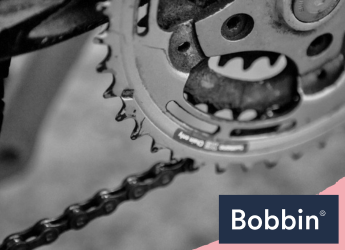On the Chain: How Do Bike Gears Work?
Ever wondered how those tiny cogs on your Bobbin bike dictate your speed and stamina? In this post, we’ll take a look at the mechanics behind these gears on your bicycle. Understanding them is key to mastering control, velocity, and endurance. If you want to know their roles in enhancing your cycling experience, then keep reading!
Why Bike Gears Matter

A myriad of components work together to create a smooth and efficient ride. Whether it’s a petite kids bike or a robust adult counterpart, these details collectively shape the character of each bicycle. Among the unsung heroes that define these wheeled marvels are bike gears.
The gears control how fast you go, making sure your pedalling matches the terrain. This bike-shifting system plays a very important role in endurance. Without it, navigating diverse landscapes would be more challenging than you might imagine.
Beyond raw speed, they enable you to save energy by maximising each pedal rotation. Think of them as conductors in your cycling orchestra, creating a perfect balance between effort and performance. Knowing the ins and outs of bike gears is the key to reaching your full cycling potential.
The Basic Components

(Image Credit: Wikimedia Commons)
The chain, the central player, links the pedals to the gears. It acts as the conductor of energy, channelling your pedalling power with ease. Without it, your pedal strokes wouldn’t connect, making the entire gear system useless.
Next is the cassette, a cluster of gears at the rear wheel. This component provides various resistance levels for different terrains. Whether you’re cruising on a flat road or conquering a steep hill, it tailors your ride to the demands of the journey.
Now, let’s look at the derailleurs, also known as the guiding force of your commuter bicycle. It works by smoothly shifting the chain between these gears for seamless transitions. This, in return, helps you maintain a consistent and efficient space. Consider them as the navigators of your cycling journey.
Together, these components form the heart of your bike gear mechanism. They translate your pedal strokes into a tailored response to the road, improving your overall ride.
How Do Bike Gears Work?

Shifting gears involves the precise interplay of components outlined above:
- chain
- cassette
- derailleurs
Imagine gears as different-sized cogs on the bike. Changing them alters which cogs the chain connects to, adjusting resistance and speed. This brings us to gear ratios, the numbers that show how the front and rear gears work together.
On flat terrain, a higher gear ratio provides speed. In contrast, lower ratios make uphill climbs more manageable. It’s akin to choosing the right tool for the job. Picture yourself pedalling your hybrid bike in a low gear (small front, large gear) uphill. With each pedal, you cover less distance but use less effort. On a downhill stretch, using a high gear (large front, small rear) lets you coast efficiently. You cover more distance with fewer pedal turns.
Learning to shift gears is like having a handy toolkit. With this skill, riding on varied terrains becomes easier on your end.
Types of Bike Gears
Like bike accessories, various types of bike gear exist. Starting with the single-speed gears, offering simplicity and low maintenance. This one-speed system is ideal for bikes for casual riding but may restrict speed options. Consider them well-suited for laid-back cyclists seeking a straightforward and hassle-free biking experience.
Next are multi-speed gears featuring various gear combinations. Aptly named, these gears offer versatility on various terrains, accommodating different cycling preferences. Their flexibility, though, may come with the trade-off of requiring more maintenance.
Internal hub gears hide the mechanism inside the wheel hub. They demand less maintenance and offer a clean look, but they can be heavier. Each type has its pros and cons. Understanding them ensures you choose one that suits your cycling needs best.
Maintenance Tips
Regularly clean gears to remove dirt and grime that can affect performance. Apply lubricant to keep moving parts functioning seamlessly, reducing wear and tear. Conduct routine inspections, checking for loose or damaged components. Maintaining your bike gears in top condition can offer the best of both worlds: 1.) enhances performance and 2.) extends the lifespan of your bicycle, especially if it’s a vintage style bike. With these simple tasks, you can ensure a smooth and efficient ride every time!
Round-up
Knowing how bike gears work is the key to a better cycling experience. The chain, cassette, and derailleurs work together, and the various gear types add versatility. Each part is essential for a smooth ride. Regular maintenance ensures peak performance. Armed with this knowledge, cyclists can conquer diverse terrains with ease. So, pedal forth with confidence!
For your biking needs, choose Bobbin, your one-stop shop. We provide a range of two wheels for all ages, along with Bobbin helmets and bike replacement parts. Coming up next: Bike Maintenance: How to Oil a Chain







